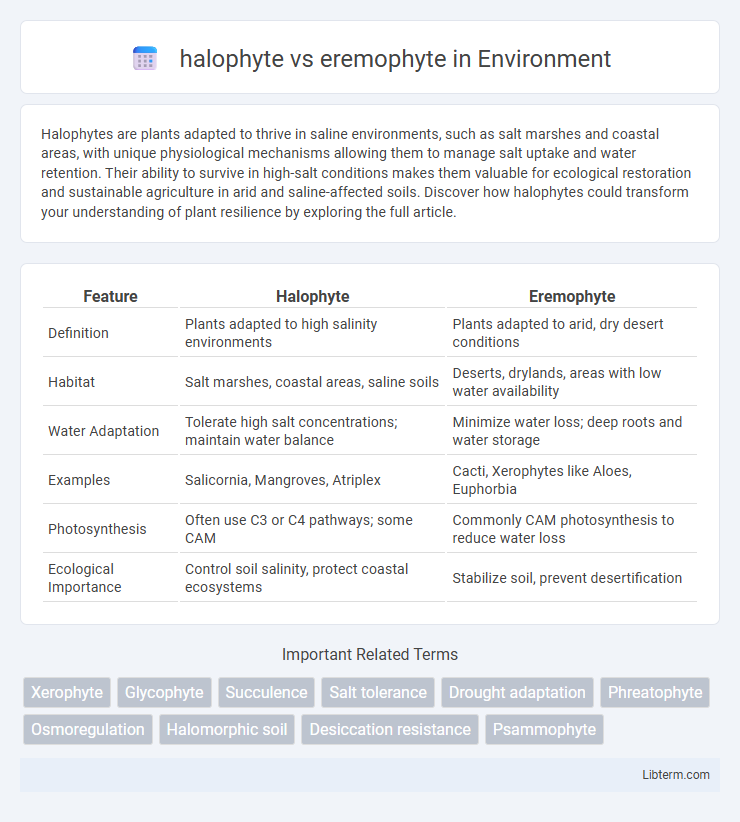Halophytes are plants adapted to thrive in saline environments, such as salt marshes and coastal areas, with unique physiological mechanisms allowing them to manage salt uptake and water retention. Their ability to survive in high-salt conditions makes them valuable for ecological restoration and sustainable agriculture in arid and saline-affected soils. Discover how halophytes could transform your understanding of plant resilience by exploring the full article.
Table of Comparison
| Feature | Halophyte | Eremophyte |
|---|---|---|
| Definition | Plants adapted to high salinity environments | Plants adapted to arid, dry desert conditions |
| Habitat | Salt marshes, coastal areas, saline soils | Deserts, drylands, areas with low water availability |
| Water Adaptation | Tolerate high salt concentrations; maintain water balance | Minimize water loss; deep roots and water storage |
| Examples | Salicornia, Mangroves, Atriplex | Cacti, Xerophytes like Aloes, Euphorbia |
| Photosynthesis | Often use C3 or C4 pathways; some CAM | Commonly CAM photosynthesis to reduce water loss |
| Ecological Importance | Control soil salinity, protect coastal ecosystems | Stabilize soil, prevent desertification |
Introduction to Halophytes and Eremophytes
Halophytes are plants adapted to thrive in high-salinity environments such as salt marshes and coastal areas, showcasing specialized salt-tolerance mechanisms. Eremophytes are xerophytic plants uniquely suited to arid desert conditions with adaptations to conserve water and withstand extreme drought. Both plant types demonstrate critical ecological roles and physiological strategies for survival in their respective extreme habitats.
Ecological Definitions and Key Differences
Halophytes are plants adapted to saline environments, thriving in soils with high salt concentrations such as coastal marshes and salt flats, while eremophytes specialize in arid desert habitats characterized by extreme drought and minimal water availability. Ecologically, halophytes employ salt tolerance mechanisms like salt excretion and ion compartmentalization, whereas eremophytes primarily exhibit drought resistance through deep root systems and water storage tissues. The key difference lies in their habitat specialization: halophytes are salt-tolerant plants inhabiting saline soils, and eremophytes are drought-adapted plants surviving in dry, desert ecosystems.
Adaptations to Saline Environments: Halophytes
Halophytes exhibit specialized adaptations to thrive in saline environments, including salt exclusion mechanisms through root selective ion uptake and salt secretion via glandular structures to maintain cellular ion homeostasis. They possess succulence, storing water in fleshy tissues to dilute internal salt concentrations and prevent dehydration under high salinity stress. These plants also enhance osmotic adjustment by accumulating compatible solutes such as proline and glycine betaine, stabilizing cellular functions during salt-induced osmotic imbalance.
Survival Strategies in Arid Regions: Eremophytes
Eremophytes survive arid regions by developing deep root systems that access underground water sources while minimizing water loss through reduced leaf surface area or modified leaves like spines. Their physiological adaptations include CAM photosynthesis, which enhances water-use efficiency by opening stomata at night to reduce evapotranspiration. Structural features such as thick cuticles and trichomes further decrease water loss, enabling eremophytes to thrive under extreme drought conditions.
Morphological Characteristics Compared
Halophytes exhibit succulent leaves or salt-excreting glands to manage high salinity, while eremophytes typically possess small or needle-like leaves and thick cuticles to reduce water loss in arid environments. Root systems in halophytes tend to be shallow and extensive to access surface moisture, whereas eremophytes often develop deep taproots for reaching underground water. Structural adaptations such as salt bladders in halophytes and sunken stomata in eremophytes optimize survival under saline and drought conditions, respectively.
Physiological Mechanisms of Stress Tolerance
Halophytes exhibit specialized physiological mechanisms such as salt ion compartmentalization in vacuoles and the synthesis of compatible solutes like proline and glycine betaine to maintain osmotic balance under high salinity. Eremophytes primarily rely on enhanced water-use efficiency, extensive root systems, and stomatal regulation to conserve water and tolerate drought stress. Both plant types activate antioxidant defense systems to mitigate oxidative damage caused by abiotic stress conditions.
Geographic Distribution and Habitat Preferences
Halophytes predominantly inhabit saline environments such as coastal marshes, salt flats, and estuaries, thriving in regions with high soil salinity found along seashores and salt-affected inland areas worldwide. Eremophytes are adapted to arid and semi-arid deserts, including sandy dunes and rocky terrains across regions like the Sahara, Arabian Desert, and southwestern United States, where water scarcity and extreme temperatures prevail. Geographic distribution of halophytes aligns with saline habitats, while eremophytes occupy dry, water-limited ecosystems with minimal soil moisture and high evapotranspiration rates.
Ecological Roles and Importance
Halophytes play a crucial ecological role by thriving in saline environments, stabilizing soil, and supporting biodiversity in coastal and salt-affected ecosystems. Eremophytes adapt to arid and desert conditions by conserving water and preventing desertification, thus maintaining ecosystem balance in drylands. Both plant types contribute to habitat restoration and provide resources for wildlife in extreme habitats.
Potential Uses in Agriculture and Restoration
Halophytes thrive in high-salinity soils, making them ideal for saline agriculture and soil reclamation projects by improving soil structure and reducing salt levels. Eremophytes are adapted to arid environments, offering drought-resistant traits valuable for restoring degraded desert ecosystems and stabilizing sandy soils. Both plant types enhance sustainable land management by supporting crop diversification and ecosystem resilience in challenging environments.
Future Prospects and Research Directions
Research on halophytes and eremophytes emphasizes their potential for sustainable agriculture in arid and saline environments, targeting crop resilience amid climate change challenges. Genetic engineering and omics technologies are advancing the understanding of stress tolerance mechanisms, facilitating the development of bioengineered plants with enhanced water-use efficiency and salt tolerance. Future studies prioritize integrating these species into agroecological systems and exploring their bioactive compounds for pharmaceutical and industrial applications.
halophyte Infographic

 libterm.com
libterm.com